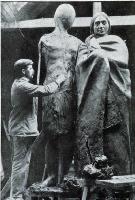Grand Hall
- The Grand Hall formed the main entrance way for visitors to the Exhibition and led into the Main Corridor.
- The Grand Hall and main corridor were designed to be impressive and were lavishly decorated with a series of sculptures and ornate fountain.
Grand first impressions
The Grand Hall was the first room of the Main Building that visitors to the Exhibition saw. It was designed to be imposing and highly decorative. The room itself was 71 foot (22 metres) square and was topped by a very beautiful dome, the top of which was 90 feet (27 metres) from the floor. The walls and ceilings of the hall were gold and lemon-coloured at the top, then a lightly tinted salmon colour, with friezes of violet with a white relief and lavender-tinted walls.
On the north of the hall, in one corner was the entrance to the offices occupied by the Chairman of the Executive of Commissioners and his staff; further on, a passage led to the rooms set apart for the Minister in Charge of the Exhibition. On the south side was the entrance to a suite of furnished rooms occupied by His Excellency, the Governor. North and south of the hall ran the main avenues, each 90 feet (27 metres) wide, with a gallery above, 20 feet (6 metres) in width, running all round them.
The Grand Hall contained a fountain, made by John Hunter of Colombo Street as "an advertisement for New Zealand craftsmanship and for the use of Oamaru stone".1 It cost the Exhibition Committee £265 to buy and install, but was later moved outside the main entrance to make way for a large Māori exhibition from Wanganui. After the Exhibition, it was sold for £30 to Mrs Joan Hammond of Merchiston.
The Main Corridor
Passing into the Main Building, westward from the entrance hall, was the Main Corridor. It was 200 feet (61 metres) in length and 62 feet (19 metres) wide, terracotta in colour with cream-tinted arches, relieved by grey, white and gold. On each side of the corridor were offices for the Telegraph Department, Post Office, Police, Customs, and other Departments. Archways along the main corridor gave access to other parts of the Main Building.
Sculptures
Thirteen statues decorated the Main Corridor, most of them representing characters from Roman and Greek mythology. In the centre was an 8 foot (2.4 metres) high group of Māori figures, sculpted by James McDonald in Carrara plaster and bronzed. The standing figures included a woman with a child and a man carrying a paddle. The seated figures depicted a carver at work, a girl making a poi ball, a youth playing a putorino (flute), and an old warrior with a mere. The sculpture was "a romanticised image of noble savages whose age is passing … the air of melancholy that pervades the group suggests there is no future for Māori except as a decorative embellishment of life in the colony".2 This idea of Māori as a "dying race" was a widely held belief at the time. Nevertheless, at least one writer to the Lyttelton times thought that the Hall should have been decorated only with Māori and Polynesian crafts, so the visitor would know at once that he was "in the land of the Māori".3 This would be much better than "cheap plaster Venuses and Cupids",4 he wrote, which European visitors could see in plenty at home, and which New Zealanders don’t want to see.
![]()
Related photos
 New Zealand International Exhibition : the grand hall with central fountain |
 The Maori group. Mr J. McDonald at work on the Maori group of figures for the Exhibition |
Sources
- Cowan, J. Official record of the New Zealand International Exhibition of Arts and Industries held at Christchurch, 1906-7
- Kernot, B. "Māoriland Metaphors and The Model Pa". In J.M. Thomson (Ed.), Farewell colonialism, page 61-78
- Lundy, J. "A grand family home; The fountain", New Zealand Historic Places, March 1994, no. 46, page 38-41
- Shaw, P. "’Supreme in all its towered majesty of white and gold’: The Exhibition Architecture". In J.M. Thomson (Ed.), Farewell colonialism, page 41- 48
- Tyler, L. "Art for Empire : Paintings in the British Art Exhibit". In J.M. Thomson (Ed.), Farewell colonialism, Description of other statues, p. 95 - 106
- Vial, J. "New Zealand and Australian art". In J.M. Thomson (Ed.), Farewell colonialism, Christchurch, 1906-07, Description of main hall, p. 107 - 116
Related links
- James McDonald in the Dictionary of New Zealand Biography.
- The passing of the Māori - what we’re coming to in Te Ara: The Encyclopedia of New Zealand
Footnotes
- [1] Lundy, J. "A grand family home; The fountain", New Zealand Historic Places, March 1994, no. 46, page 38-41
- [2] Kernot, B. "Māoriland Metaphors and The Model Pa". In J.M. Thomson (Ed.), Farewell colonialism, page 62
- [3] "The Exhibition", Lyttelton Times, 13 July 1906, page 4
- [4] "The Exhibition", Lyttelton Times, 13 July 1906, page 4




